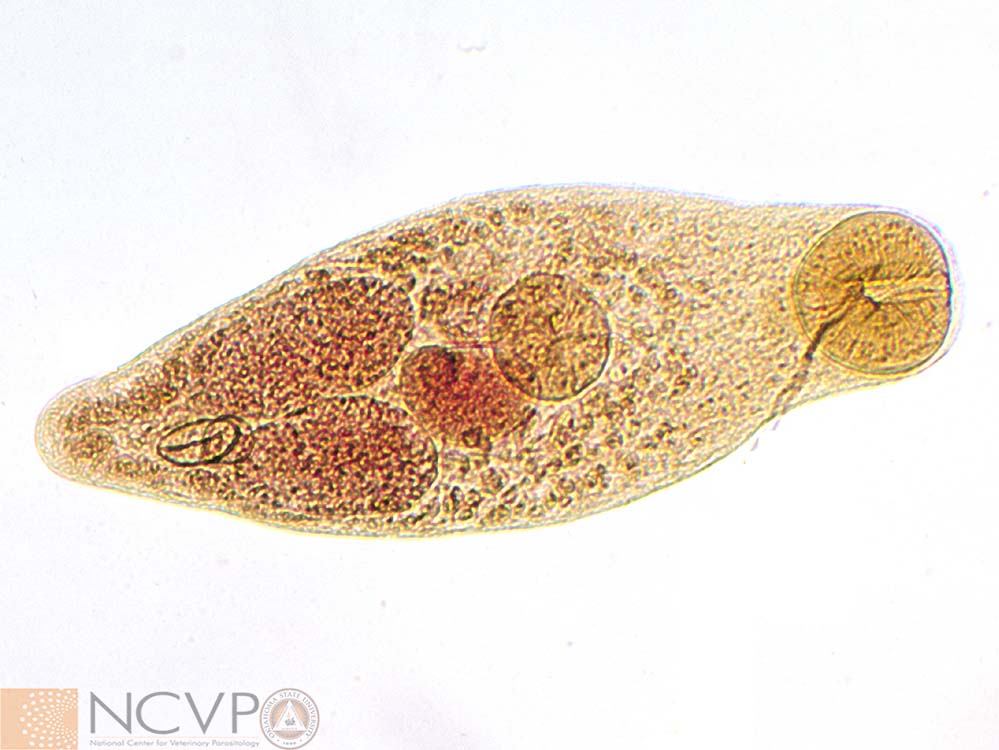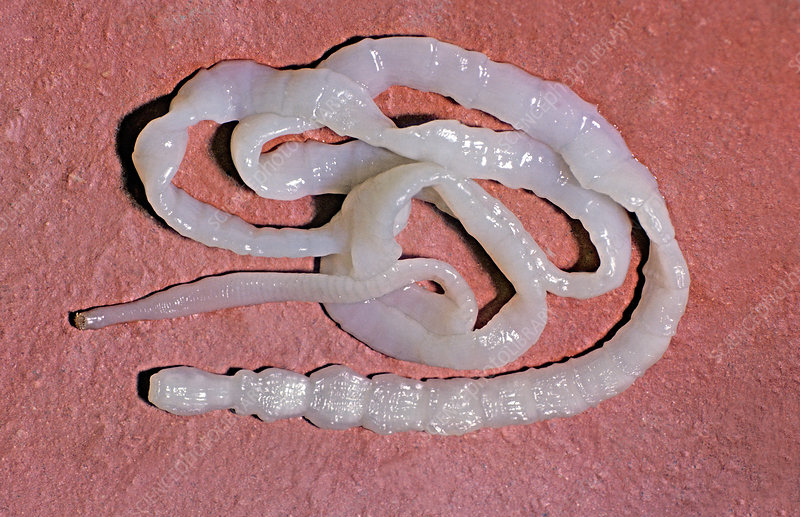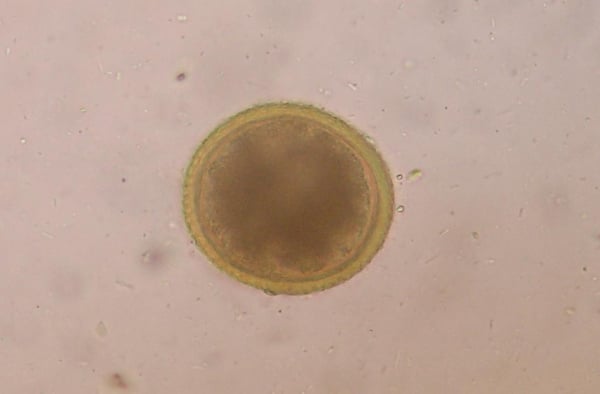Veterinary Science- Parasitology
1/90
Earn XP
Description and Tags
Notes from Parasitology presentation. Made for New Horizons Veterinary Science class.
Name | Mastery | Learn | Test | Matching | Spaced |
|---|
No study sessions yet.
91 Terms
Parasitology
the study of parasites
Parasite
a living organism that obtains nourishment from another living thing that does not benefit from the relationship
Host
the organism that provides the parasite with nutrients/place to develop
Intermediate Host
an organism that supports the immature/nonreproductive forms of a parasite
Ova
Egg
Larva
an immature form of a parasite, often a worm-like organism
Vector
an organism that spreads a disease-causing pathogen
Ectoparasites
parasites that live outside of the body
Endoparasites
parasites that live within the body
Classifications of Parasites
Protozoa/Protozoans
Helminths
Arthropods
Protozoa/Protozoans
single celled organism, some of which can be parasitic whereas others can live freely without a host
Helminths
broad term for parasitic worms
Types of Helminths
Nematode
Trematode
Cestode
Characteristics of Nematodes
round, long parasitic worms; non-segmented
Characteristics of Trematodes
flat, leaf-like worms
Characteristics of Cestodes
flat, segmented worms

What type of helminth (parasitic worm) is this?
Nematode (Roundworm)

What type of helminth (parasitic worm) is this?
Trematode (Nanophyetus salmincola)

What type of helminth (parasitic worm) is this?
Cestode (Tapeworm)
Arthopods
ticks, lice, fleas, mites
Can you look at a patient and determine if they are battling parasitism?
NO
There aren’t always physical signs of parasitism, and some parasites can cause minimal signs that aren’t even recognizable. Additionally, most live within the host and are microscopic.
Can parasites impact the pet owner?
YES
Can be zoonotic
Can act as vectors for human diseases
Causes significant illness in pets
Create a financial burden
Potentially Zoonotic Parasites (Name 3)
Roundworms
Giardia
Ticks (vectors of Lyme disease & Rocky Mountain Spotted Fever)
Fleas
Certain tapeworms
Toxoplasma gondii
Roundworms
Hookworms
How can you prevent parasitism?
Flea/Tick prevention
Heartworm prevention/Monthly Gastrointestinal parasite prevention
Basic hygiene (picking up feces in the yard)
Why is it important to pick up feces right away?
Picking up feces is an important step in regulating the environment and preventing parasitism. Many parasite eggs will be passed on through feces and will sporulate (become infective) after being in the environment for a while. It’s imperative to pick feces up as soon as you see it to prevent parasites from becoming infective and your dog from consuming it.
Examples of Protozoans
Coccidia
Giardia
Toxoplasmosis
Coccidia
gastrointestinal parasite that can cause diarrhea, weight loss, dehydration; there are many types of coccidia, and they tend to be species specific
Coccidia Life Cycle
Eggs (oocysts) are deposited into environment via feces and sporulate
Once consumed, oocyst ruptures in the GI tract and burrow into intestinal lining
Develops into different phases while in intestinal lining —> damaged intestinal cells (origin of clinical signs)
Reproduction occurs inside lining and eggs are released
Coccidia Diagnosis & Treatment
Diagnosis: Fecal floatation test
Treatment: Animals w/o treatment and otherwise healthy may not require treatment. Animals w/ clinical signs and + fecal test should be treated (Sulfa drugs).
ENVIRONMENTAL CONTROL IS CRUCIAL TO PREVENT REINFECTION
Giardia
gastrointestinal parasite common in dogs that comes in various, species specific “assemblages”; can cause diarrhea and weight loss
Giardia Life Cycle
Trophozoite form of giardia lives in intestines and is mobile due to flagella
Attaches to intestinal wall and multiplies via binary fission
Encysted form will pass into environment via feces and remain viable in supportive environments
Cyst is infective and leads to infection once consumed
Giardia Diagnosis & Treatment
Diagnosis: Fecal floatation test, Antigen test
Treatment: Treatment may not be needed. Should be considered if living with an immunocompromised individual
Toxoplasma gondii
causative agent of toxoplasmosis; rarely can cause fever, lethargy, loss of appetite and pneumonia in cats or jaundice depending on where it encysts
Toxoplasmosis
Zoonotic parasite found in cat feces that can cause miscarriage in humans
Toxoplasma gondii Life Cycle
Oocysts passed in feces, becomes infective after 1-5 days
If picked up by cat, life cycle is complete
If picked up by another animal, oocyst will continue to develop and encyst in tissue ↓
Cats can become infected if they ingest an animal w/ encysted toxoplasma
Toxoplasma will break down cyst and reproduce in GI cells
New forms of toxoplasma produced and travel to other tissues in body
Toxoplasma gondii Diagnosis & Treatment
Diagnosis: Can be challenging. Blood test can identify antibodies, but this could mean EXPOSURE and not actual illness. Fecal test is unreliable as Toxoplasma oocyst looks similar to other parasites. May need tissue biopsies
Treatment: Antibiotics
Roundworms (Toxocara spp.)
gastrointestinal parasites once mature; immature forms travel through body (i.e. lungs and liver) and cause clinical signs; transmitted via ingestion (of eggs or paranteric host), in-utero, or infected milk; extremely common, should be assumed all pups/kits have them and should be routinely dewormed

Roundworm egg
Roundworm Symptoms
vomiting/diarrhea
failure to gain weight
poor coat quality
pot-bellied appearance in puppies/kittens
Roundworm Diagnosis & Treatment
Diagnosis: Fecal test identifies egg
Treatment: Supportive care, repeated deworming, appropriate medication (”strongid,” monthly heartworm prevention)
Roundworms in Humans
Zoonotic potential; leads to larval migrands which are extremely uncomfortable which can lead to blindness in children; hygiene is important to teach children to prevent accidental contamination
Hookworms (Ancylostoma spp.)
gastrointestinal parasite that sucks blood by latching onto intestinal wall with their 6 teeth; zoonotic and can be transmitted via in-utero, infected milk, contact with infective larva, ingestion (infected animal or environment)

Hookworm egg
Hookworm Symptoms
diarrhea
pale mucous membranes
lethargy
weakness
in severe cases, anemia
can also cause cutaneous larval migrans
Hookworm Diagnosis & Treatment
Diagnosis: Fecal float identifies egg
Treatment: Routine heartworm prevention, dewormers (only effective to parasites within intestines)
Whipworms (Trichuris spp.)
gastrointestinal parasite that sucks in the cecum; infected barely show signs unless burden is high; potentially zoonotic

Whipworm egg
Whipworm Diagnosis & Treatment
Diagnosis: can be difficult; whipworms have intermittent reproduction cycle so sometimes eggs are not detectable
Treatment: Strenuous deworming
Heartworms
serious, preventable disease that can affect dogs and cats; spread via mosquitos; worms live in pulmonary artery and can spread to other chambers, drastically changing heart function leading to heart failure and death
Heartworm Life Cycle
Adult worms give birth to microfilaria (L1) while living in pulmonary artery (live birth)
L1 is picked up by feeding mosquito
Develops into L2 and L3 stage within mosquito
Mosquito feeds on another host, deposits L3 in spitball besides bite which then enters wound
Must be humid within environment
Develops into L4 where it lives in skin for 3 months until it matures into L5
L5 goes into circulation and homes in pulmonary artery
Heartworm Diagnosis & Treatment
Diagnosis: “Snap” Test identifies female adult heartworm antigen; Knotts Test identifies microfilaria; takes at least 6 months from time of infection for diagnosis due to life cycle; No test can detect L3, L4, L5
Treatment: Need to kill parasite of heartworm 1st (WOLBACHIA via Doxycycline and Prednisone). To kill actual heartworm, needs 3 injections of Melasrsomine dihydrochloride DEEP into epaxial muscles of the back (very uncomfortable). Expensive, dangerous, and requires exercise restricted. Dead worms can get lodged and cause EMBOLI causing respiratory emergencies
Nanophyteus salmincola
fluke that carries ricketseial bacteria that causes salmon poisoning; spread via ingestion of raw fish in Pacific Northwest that harbor fluke
Nanophyetus salmincola Symptoms
Rickettsia will travel through body to infect liver, lungs, lymphoid tissues, and brain
nausea
fever
lymph node enlargement
seizures
difficulty breathing
vomitig
bloody diarrhea
weight loss
nasal/ocular discharge
Nanophyetus salmincola Diagnosis & Treatment
Diagnosis: History and location of patient; Identifying fluke eggs in feces (fecal float)
Treatment: Supportive care, antidiarrheals, anti-vomit, antibiotics, blood transfusions, medications to kill fluke
Large portion of dogs will die within 7-10 days of clinical signs if not treated. If treated - prognosis is good!
There are _____ types of tapeworms. _____ is harmful to humans and has zoonotic potential.
MANY; Echinococcus multilocularis
Diplylidium caninum
specific tapeworm that infects dogs through ingestion of infected flea; does little harm to host; can also be zoonotic but humans must ingest infected flea
Proglottids
Tapeworm eggs that are deposited into environment; have digestive and reproductive systems
Dipylidium caninum Diagnosis & Treatment
Diagnosis: visualizing “grains of rice” (proglottids) around rectum, on feces, or in environment; pet doesn’t have to have fleas to have tapeworms
Treatment: Oral dewormer to target tapeworms, controlling fleas
Taenia spp.
species of tapeworms that infects animals through ingestion of raw meat; lifecycle similar to dipylidium (lives in intestines, grows proglottids), ingested by intermediate host and travels to liver and encysts in abdomen; has zoonotic potential
Taenia spp. Diagnosis & Treatment
Diagnosis: Visualizing proglottids
Treatment: Administering dewormer
Ectoparasites
Ticks
Fleas
Mites
Lice
Types of Ticks
15 types in North America. Most common concern are:
American Dog Tick
Lonestar Tick
Deer Tick
Browndog Tick
Tick Life Cycle
Eggs- fertilized female lays eggs
Larvae- Eggs hatch into 6-legged larvae
Nymph- Larvae molt into 8-legged nymph in environment
Adult- Nymph molts into 8-legged adult
Ticks
bites and attaches to skin and sucks blood; transfers diseases, some of which spread quickly and others require more time; attached ticks should be swiftly removed
Diseases Transmitted via Ticks
Rocky Mountain Spotted Fever
Anaplasma*
Ehrlichia*
Lyme*
*regularly screened for in Snap Tests
Tick Removal
Don’t remove w/ fingers
Use tweezers, grasp tick close to skin
Pull straight up, do not twist or squeeze
Once removed, clean skin w/ alcohol or soap and water
Don’t squish tick- submerge it, flush, or seal it
Monitoring Tick Bites
Bite will leave behind small, itchy bite wound which should be closely monitored for infection; not all dogs with tick borne disease will show signs, if dog has been bit in recent history and is showing signs, see a vet ASAP
Snap 4Dx
tests dog’s blood simple in-office test requires only a few drops of your dog’s blood, and can within minutes diagnose Lyme disease, ehrlichiosis, and anaplasmosis.
Serology
Serum, which is the liquid part of your dog’s blood, is sent to a veterinary diagnostic lab and tested for antibodies against tick-borne diseases.
Blood Smear
A drop of blood is spread on a glass slide, stained, and viewed under a microscope to check for signs of infection or infectious organisms.
Polymerase Chain Reaction (PCR)
A blood, joint fluid, or lymph node sample is sent to a lab for testing to diagnose tick-borne diseases.
Blood Work
check your dog’s red and white blood cells, platelets, and internal organ function. While this test alone does not diagnose tick-borne diseases, it’s helpful to assess your dog’s overall health.
Urinalysis
Urine testing can help assess your dog’s kidney function and can identify protein in the urine, which may indicate a tick-borne disease.
Tick Borne Disease Treatment
antibiotics (doxycycline)
NSAIDs/Steroids reduce inflammation and discomfort
Important to regularly check dog for visible parasites to prevent disease, remove ticks, utilize preventative medications year round
Fleas
small, common, external arthropods that cause itchiness, skin irritation, secondary infections, and transmit diseases; zoonotic
Flea Life Cycle
Egg- fall into environment; 40 a day
Larvae- hatch and move to shady environment to make cocoon
Pupae- lives in cocoon; hatches due to vibration, light, or carbon dioxide
Flea- only adult stage lives on host; doesn’t
Signs of Fleas
itchy
red bumps
overgrooming
redness of skin
hair loss
severe cases can cause anemia
can be vectors of disease
tapeworms, bubonic plague, bartonella
Flea Diagnosis & Treatment
Diagnosis: Clinical signs, visualization of flea/flea dirt, lack of preventatives, location of irritation
Treatment: may be needed to address secondary problems, treat flea itself via preventatives, environmental cleaning, vacuuming, washing bedding
Flea/Tick preventions could be used on other animals (Off Label Use)
Types of Mites
Walking Dandruff
Scabies
Demodectic Mange
Ear Mites
Sarcoptic Mange (Scabies)
contagious parasite that causes intense itch; zoonotic though dogs are their favorite; transmitted via contact
Scabies Life Cycle
Completed entirely on dog
Females burrow tunnels in the skin and lay eggs
Hatch after a few days and larva also burrow tunnels
Molt 2x as nymphs
Adults mate in skin
Scabies Symptoms
itchy
inflamed skin
hair loss
inflammation
darkening of skin
oozing sores
Scabies Diagnosis & Treatment
Diagnosis: Skin scraping (scraping skin with dull blade and evaluating skin cells)
Treatment: Treatable but takes a long time; heartworm prevention may help
Demodectic Mange (Demodex spp.)
normally found in skin within hair follicle; disease occurs with overabundance as result of immune compromise; transmits via direct contact
Signs of Demodex
patchy hair loss
generally not itchy
localized or generalized
common in dogs less than 6 months
Demodex Diagnosis & Treatment
Diagnosis: Deep skin scraping
Treatment: No specific product though flea/tick products work extralabel, treat underlying conditions, may resolve on own
Cheyletiella spp. (Walking Dandruff)
non-burrowing mites that live on skin; mobile; contagious via direct contact or fleas, lice, and flies; causes flaky dandruff; low zoonotic chance
Otodectes cynotis (Ear Mites)
mite that lives within ear; more common in cats than dogs; low zoonotic chance; lead to ear infections
Ear Mites Diagnosis & Treatment
Diagnosis: Ear swab evaluated under microscope; can cause neurologic damage if too far deep
Treatment: Heartworm preventatives, cleaning out debris
Lice
flat, wingless insect similar in size to flea; not zoonotic; two types:
Biting/chewing eat tissue debris
Sucking lice feed on blood
Cause scratching, excessive biting, restlessness
Lice Diagnosis & Treatment
Diagnosis: visualizing lice, confirming under microscope
Treatment: flea/tick products